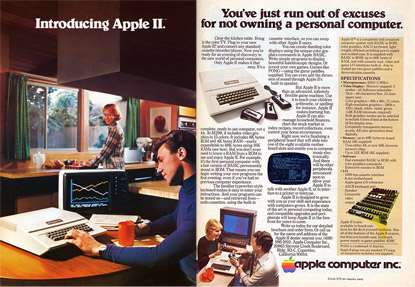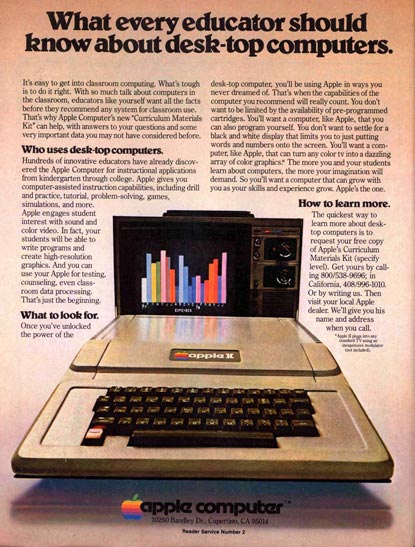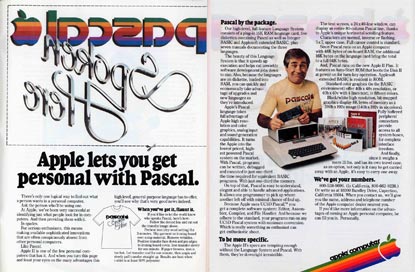Among the many, many things we talk about when we discuss curriculum for the Computational Media degree is how to make learning programming facile and appealing all throughout a student’s career. Many sub-problems arise, for example, how can one help students learn new languages and environments after they’ve become familiar with one or two?
Just after having some of these very conversations I happened to fall upon a treasure trove of old Apple ads. It reminded me of something we often mention on the Computational Media curriculum committee: many of us learned to program because that’s what one did with a personal computer. Looking at these ads really drives this point home.
Here’s a two-page spread from 1977, the first year of the Apple ][. It ran in Scientific American, among other publications. (Click any of these for larger images).
The text is a bit small even in the large version, so I’ll reproduce some key passages:
But you don’t even need to know a RAM from a ROM to use and enjoy Apple II. It’s the first personal computer with a fast version of BASIC—the English-like programming language—permanently built in. That means you can begin running your Apple II the first evening, entering your own instructions and watching them work, even if you’ve had no previous computer experience.
That’s the second paragraph of the ad copy. The implication is clear: you’re going to bring home your new $1298 Apple ][, set it up on your kitchen table, and start writing some programs. And not just because you’re a dork who reads Scientific American; no, the ad continues to explain that everyone in your house can learn to do it:
But the biggest benefit—no matter how you use Apple II—is that you and your family increase familiarity with the computer itself. The more you experiment with it, the more you discover about its potential.
What’s more, the ad suggests an organic oscillation between using the computer and programming it, the one influencing the other.
Start by plaing PONG. Then invent your own games using the input keyboard, game paddles and built-in speaker. As you experiment you’ll acquire new programming skills which will open up new ways to use your Apple II. You’ll learn to “paint” dazzling color displays using the unique color graphics commands in Apple BASIC, and write programs to create beautiful kaleidoscopic designs. As you master Apple BASIC, you’ll be able to organize, index and store data on household finances, income tax, recipes, and record collections. You can learn to chart your biorythms, balance your checking account, even control your home environment.
Finally, there’s a clear implication that becoming more fluent in computing involves becoming a more agile and determined programmer, not merely a more adept user:
Best of all, Apple II is designed to grow with you. As your skill and experience with computing increase, you may want to add new Apple peripherals. For example, a refined, more sophisticated BASIC language is being developed for advanced scientific and mathematical applications. And in addition to the built-in audio, video and game interfaces, there’s room for eight plug-in options such as a prototyping board for experimenting with interfaces to other equipment.
Here’s another one, although I haven’t been able to pinpoint its date. It’s an ad targeting educators, presumably for institutional purchases.
Here too we see programming listed as an inevitable rather than a possible use of the machine:
Apple engages student interest with sound and color video. In fact, your students will be able to write programs and create high-resolution graphics.
And then later a sentiment that feels almost entirely alien from the perspective of Apple in the 21st century, one that reprises the 1977 ad’s implication that programming is an inevitable consequence of owning a computer:
Once you’ve unlocked the power of the desk-top computer, you’ll be using Apple in ways you never dreamed of. You don’t want to be limited by the availability of pre-programmed cartridges. You’ll want a computer, like Apple, that you can also program yourself. … The more you and your students learn about computers, the more your imagination will demand. So you’ll want a computer that can grow with you as your skills and experience grow.
The last sentence above is fundamental to the personal computer experience of the late 1970s and early 1980s. Straight out of the box, anyone could make the computer do something. And then, soon enough, anyone with a little patience and interest could make the computer do anything it was capable of.
One more. This 1979 print ad promotes the availability of a Pascal development environment for the Apple ][.
It’s is an amazing spread, partly because it includes an iron-on decal that would produce a t-shirt with the message “Pascal Spoken Here.” But the ad also makes good on the promise made in the 1977 ad above, by offering more advanced tools to help improve an owner’s ability to program the machine.
With Pascal, programs can be written, debugged and executed in just one-third the time required for equivalent BASIC programs. With just one-third the memory. On top of that, Pascal is easy to understand, elegant and able to handle advanced applications. It allows one programmer to pick up where another left off with minimal chance of foul up.
The mention of foul ups conjures those lovely yet horrifying BASIC magazine listings, one of the standard ways to distribute and share programs at the time. Pascal, as it happens, went on to become the native development environment for the Apple Lisa and the original Macintosh. I remember programming System 6 and 7 in Object Pascal, and Apple supported the language up until the IBM PowerPC architecture switch in 1994.
I point to this last example to underscore the good fortune that blessed those of us who started using computers in this era. Learning a new language or environment was a far less frequent and more specific affair, and yet a far more familiar and comfortable one. Why? Because it was possible to learn to program computers in time with their very evolution.
Today when we ask questions like those I posed at the top of the page, we may fail to remember that it’s precisely these contexts we lack, rather than technical scaffolding or learning environments or what have you. These vintage Apple ads should make clear how difficult it is, perhaps even impossible, to recuperate a situation in which a computer doles out its secrets in small, digestible bites rather than all at once through the tsunami of Google results.



Comments
Mark Nelson
A timely reminder, given the complete opposite tone of Apple’s current advertising! Elaine Lally argues that the shift in the late 1980s/early 90s was a deliberate move to broaden the market, as computer manufacturers (not just Apple) changed the tone of their advertising to downplay its educational/business possibilities, and instead play up its role as just another normal, unthreatening commodity in the array of modern household electronics. Possibly a successful shift commercially, if unfortunate for the reasons you describe.
Related, has anyone (besides this blog post) written an analysis of the role of education in early computer advertising? I can find plenty on the role of gender in early computer advertising, say, but nothing on the rhetoric of learning/education/etc., which seems pretty widespread— both in standalone home computer ads like these, that emphasized the user’s exploration/learning/growing with the device, and, even more explicitly, in the anti-game-console ads from home-computer manufacturers wanting to emphasize how mind-expanding their computers were in contrast to what they portrayed as mere mindless-entertainment-machines. It seems someone in some field must’ve written something on that rhetoric 20 years ago, but I can’t turn up a journal article or book chapter with the search terms I’m using.
John Stracke
Right, that was Applesoft BASIC, a Microsoft port. The earlier version was Integer BASIC, which Woz wrote in hex. I suppose the “advanced scientific and mathematical applications” is sort of valid, since scientific programming generally requires floating point.
Craig
I agree: I learned to program because I had an Apple ][. Most of the young people I know have computers, but don’t know how to program at even the most basic level.
Matthew Kirschenbaum
Right on. Matches my own experiences with my childhood Apple–still in my office in good working order–exactly. I think there’s room for a really interesting convergence between retro computing and the pedagogy of programming.
Ian Bogost
@Mark
You’re surely right about the market-broadening. I can’t help but wonder how things might have been different if Woz had had some of the personality of Jobs. Or if Sculley had, well, done things differently. But surely this change was already happening at the time of the original Macintosh too.
As for your question about studies of the role of education in computer advertising, I don’t know of any. I suspect studies of computer advertising are scarce on their own.
@John
Ah yes! Woz wrote Integer BASIC manually in hex, without an assembler even. What fun!
@Craig
And it’s not just the Apple ][, but also many other PCs of this era that could be programmed out of the box, and that very much encouraged it. But the Apple ][ is really the granddaddy of that trend.
@Matt
That’s exactly the where my thoughts on this subject are heading. Not just retro computing though, but the material history of computing as a frame for learning to make machines do things.
Apreche
Yin and Yang. Jobs and Woz. You’re article can basically be summed up in five words.
Apple used to have Woz.
Aaron Lanterman
I was introduced to the Apple ][ when I was around 10 years old, and it is why I have the job I do today. I could probably even tag one specific game: Akalabeth. That line-drawing Balrog was a thing of wonder and mystery. And if you were clever – you could list the game and see how it ticked.
One interesting tidbit in the old advertisement is the mention of a “peripheral board… [that will[ enable you to compose music electronically.” I wonder what it was referring too: the boards I can think of along those lines were the Mockingboard (Sweet Micro Systems) and the Mountain Computer Music System, neither of which were Apple-designed products.
Malcolm MacDonald
All I want to do is to obtain an up to date version of Pascal,
which I used with my old computer in the early 2000 years.
I would like a new version to work on my new Apple computer
model X 105.8.
Is this possible to obtain ?
Malcolm
Malcolm MacDonald
I would like a new version of Pascal to work on my new Apple computer
model X 105.8.
Is this possible to obtain ?
Malcolm